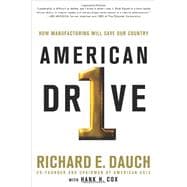
RICHARD E. DAUCH is chairman, CEO, and co-founder of American Axle and Manufacturing. He is a former manufacturing executive at Chevrolet, Chrysler, and Volkswagen, and has worked in the automotive industry for more than forty-eight years.
“Leadership is difficult to define, but I know it when I see it. Dauch is a born leader whose ability to inspire loyalty and extraordinary performance is a natural phenomenon.” —Lee Iacocca, former chairman and CEO of the Chrysler Corporation
“The story of Dick Dauch and his success in business, in the community, and with his family makes a great read. There are important lessons for all of us—about discipline, courage, passion, education, competitiveness, loyalty, and values. Read it and marvel. Read it and learn.” —Dr. Martin C. Jischke, president emeritus, Purdue University
“Dick builds strong teams that share a desire for enterprise and personal success. He provides clarity of purpose, rules of engagement, and rewards systems that result in exceptional business performance.” —Jim McCaslin, former president and COO of the Harley Davidson Motor Company
“Dick is an inspirational leader, a straight guy, somebody you would follow over a hill out of your trench into battle. He has a terrific command personality. In my business, when you have a company with a good structural situation and investment premise, and your management is a ten, which is what Dick Dauch is, you’re going to have a terrific success.”—Stephen A. Schwarzman, chairman, CEO, and co-founder of the Blackstone Group
“I most admire people who operate well in times of adversity. Even in the worst of times, Dick Dauch had a positive sense of the future and was committed to investing in the future.”—Peter G. Peterson, chairman of the Peter G. Peterson Foundation and co-founder and chairman emeritus of the Blackstone Group
“Dick Dauch took a group of underperforming assets and built a business that is arguably among the top suppliers in the automotive industry by developing a vision that focused on execution, quality, and a can-do attitude.”—Roger S. Penske, chairman of the board and CEO of Penske Automotive Group, Inc.
The New copy of this book will include any supplemental materials advertised. Please check the title of the book to determine if it should include any access cards, study guides, lab manuals, CDs, etc.
The Used, Rental and eBook copies of this book are not guaranteed to include any supplemental materials. Typically, only the book itself is included. This is true even if the title states it includes any access cards, study guides, lab manuals, CDs, etc.